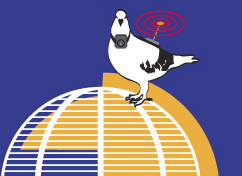ISEA2006 Symposium Poster Sessions
|
Aug 04, 2006 at 12:00 AM |
China, Wikipedia, education, censorship, content creation This presentation serves as a link into the digital media discourse in China. As such it is not narrowly focused but highlights 3 critical avenues into a more practical oriented discussion suggested by the nature of the ISEA2006 proposal of an Asia-Pacific Summit: censorship, creative industry and education. I see the major challenge to China in terms of its entrance into the era of read/write media. From this perspective the above issues can be looked at in terms of the rocky introduction to wiki/blog culture, user created content/production, and the use of collaborative software in education. |
|
Last Updated ( Aug 05, 2006 at 12:14 PM )
|
|
Read more...
|
|
|
Cityscapes: Social Poetics/ Public Textualities |
|
Apr 23, 2006 at 10:46 PM |
audiovisual collages, interactive, interphonetic and multicultural textualites, urban calligramme, participatory web, discovery, exploration, multiplicity, diversity, urban screen. The project is a continuation of my doctoral research in Visual and Digital Poetics, with an interest in the new and still unexplored genre of e-poetry and how it is integrated in the realm of social and urban poetics. It is an interactive piece formed by pallets with audio, animated and visual elements of the multicultural city of Melbourne. The user can create phonetic and textual-visual compositions. The ultimate aim is to make this work accessible via the web to enable users to recreate these fragmented realities and send them back to the city, to a common urban screen. |
|
Last Updated ( Aug 07, 2006 at 02:00 AM )
|
|
Read more...
|
|
|
Concepts in Locative Media: Instrumental and Theoretical Considerations in the Design of a Framework |
|
Aug 04, 2006 at 12:00 AM |
mobility, city as interface, urban fiction, locative media, third space This poster is concerned with the development of a conceptual and technological framework for the realization of locative media artworks. Our approach focuses on multiplicity and hybridity, and seeks to create an instrument out of the urban environment. Mobile phones become the instruments that probe into the urban fabric and the lenses that modulate the way we perceive this web of threads. The poster looks at the instrumental and theoretical framework and three concepts that put them into practice. This poster was co-authored by Dr. Atau Tanaka. Finical support provided by Cultural Services of the French Embassy, Consulate General of France in San Francisco.
|
|
Last Updated ( Aug 04, 2006 at 06:13 PM )
|
|
|
Written by Kuniko Vroman
|
|
Apr 23, 2006 at 10:43 PM |
inclusive urbanism, new media, education, youth, park, public dialogue, urban curating, open source architecture During the first half of 2005 an unusual project took place in Slotervaart, initiated by the Rotterdam artist Jeanne van Heeswijk and architect Dennis Kaspori. It involved the design of the Staalman Park, which, together with the Brede School which stands next to it, is to form the new heart of this neighbourhood in Amsterdam West. The point of departure for the project was not only to arrive at a design for the park, so that it could function as a meeting place for residents of various ages and cultures, but above all else, to bring this about with the participation of the future users, including children, students and other neighbourhood residents. The Stedelijk Lab project Face Your World allowed young people to investigate their own surroundings, and gave them instruments for changing their environment, as real urban planners. An important facet of Face Your World is what is called the Interactor. This specially-developed multi-user 3D design software enables users to themselves design their neighbourhood in a network environment, and to make adjustments as necessary at any random moment in the process. In July 2005 the presentation of the final results – well attended by the neighbourhood – took place in the presence of district politicians and the Secretary of State for Culture, Medy van der Laan. It is nice to report that the design – including the many details that were worked out by the neighbourhood team – will apparently be realised. in October 2005 The Stedelijk Museum Amsterdam has hosted a presentation of the process and the end results. The presentation consisted of various workshops and panel discussions. The Sandberg Auditorium was rebuilt as an information studio in which visitors will be informed about the project and where it will be going from here. Neighbourhood participation, political decision-making and creative thinking are intertwined with one another. In these discussions there will be attention given to, successively, the complex relationship between visual art and resident participation, the problems surrounding the large-scale operation of urban renewal, and the challenge of involving a cultural dimension in an urban design assignment. |
|
Last Updated ( Aug 07, 2006 at 01:56 AM )
|
|
Read more...
|
|
|
Free radio and community networks |
|
Apr 23, 2006 at 10:36 PM |
radio, broadcasting, wireless, digital, networks, social, community, grassroots technology In this poster I aim to reconsider the role of radio broadcasting on a local level, and examine the interesting revival in this
'secondary' medium as a tool for community awareness and creative expression. Community radio broadcasting as a movement for social empowerment is undergoing transformation and expansion. Grassroots wireless digital networks are enabling localised sharing of bandwidth and services. This poster will explore these phenomena, looking at examples of projects, comparing and contrasting approaches and positions, and analysing issues.
|
|
Last Updated ( Aug 07, 2006 at 01:52 AM )
|
|
Read more...
|
|
|
Free Network Visible Network |
|
Aug 04, 2006 at 12:00 AM |
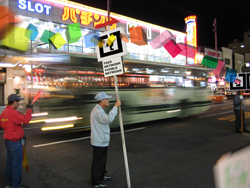 digital networks, digital freedom, public space, augmented reality digital networks, digital freedom, public space, augmented reality
Free Network Visible Network combines different tools and processes to visualize, floating in the space, the interchanged information between users of a network. People are able to experience how colorful virtual objects, representing the digital data, are flying around. These virtual objects will change their shape, size and color in relation to the different characteristics of circulating information in the network. Using the Visible Network Client users can superimpose images, texts, sounds and 3D models on the urban space customizing it and participating on the design of the city. Free Visible Network is done in collaboration with Liu Wei, Duy Nguyen and Adrian Cheok at IERC, Nanyang Technological University, Singapore. |
|
Last Updated ( Aug 07, 2006 at 01:51 AM )
|
|
Read more...
|
|
|
Apr 23, 2006 at 10:42 PM |
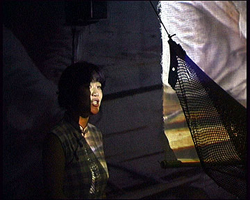 socio-cultural, socio-aesthetic, nation, boundary, deportation, geography, perspective, re-frame, re-interpret, collaborate socio-cultural, socio-aesthetic, nation, boundary, deportation, geography, perspective, re-frame, re-interpret, collaborate
What If I'm Not Real is a multi-screen installation work in which the broad ranges of cultural backgrounds and disciplines of artists were able to engage with their shared global contexts for migrations and deportations without the assumption of consensus of perspective. The resulting visual and physical narrative is able to allow different musical performance artists to each reframe the way the work is perceived, so cutting across cultural divides re-locating the same visuals within different geographies and perspectives. The work questions techno-insularity and proposes greater roles for continuing live evolution of electronic screen-based arts, and for the confounding of the real-symbolic between visuals and music. |
|
Last Updated ( Aug 07, 2006 at 01:55 AM )
|
|
Read more...
|
|
|
Aug 04, 2006 at 12:00 AM |
parasite, generative design, performative situation, adaptive architecture, responsive environment We propose to tell a story of the design and construction of a place-specific responsive environment. This story is fundamental to the problem of materialisation of structures that are derived via an adaptive simulative process. Rather than seeing the purpose of the project in an object we recognise how a task of making physical a digitally evolved idea is a near-absurdist endeavour resembling that described by Kafka in The Great Wall of China. The Sisyphusean move from bytes to matter has involved tens of people and has spread from the city of Cambridge to the city of Prague. In our view, seeing this project for what it is suggest a new theoretical way of seeing and appraising both contemporary cutting-edge architectural design and digital art. We have documented the design and materialisation processes, the interaction with people and the places and have compiled the results into a 25min film that includes video and animated simulation sequences.
|
|
Last Updated ( Aug 07, 2006 at 01:48 AM )
|
|
Read more...
|
|
|
Aug 04, 2006 at 12:00 AM |
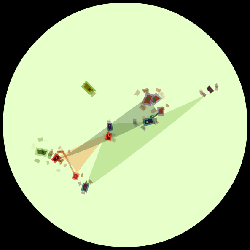 fish, audio, composition, animation, underwater, installation, site-specific, lake, art, unpredictable systems fish, audio, composition, animation, underwater, installation, site-specific, lake, art, unpredictable systems
The Lake is the first in a series of artworks that track groups of animals via electronic tagging systems and transforms the motion data collected into musical composition and animated visuals. Supported by NESTA and presented at Tingrith Fishery, UK, the site-specific work collected real-time movement data from sixteen fish and used a modular software system to create a unique digital audiovisual experience for visitors. The work explores how we can create an interface for communication between biological systems and technological systems in an artistic context. |
|
Last Updated ( Aug 07, 2006 at 01:58 AM )
|
|
Read more...
|
|
|
Locative Processes of Re-Imagining Cities – Media as Spatial Intervention |
|
Aug 04, 2006 at 12:00 AM |
|
The poster aims at examining urban change and the production of urban cultural space from the viewpoint of media. The focus is on how spaces and frequencies intertwine. Thus, urban media is seen as standing for both media of public space and media as public space. Especially various locative processes of street television are analysed as a mode of spatial intervention for re-imagining cities. The case of Helsinki, its specific media-space and the development of the m2hz urban channel are analysed in this context. |
|
Last Updated ( Aug 04, 2006 at 06:54 PM )
|
|
|
Aug 04, 2006 at 12:00 AM |
city, visualization, semantics, interpretation, meaning, commonsense Can computers understand what a space means to us? We think so, and demonstrate a system that seems to feel the same way. By making use of common-sense knowledge what an average person takes a way from a place we can build visualizations that aren't dependent on what we put in a database - just what we can describe with language. |
|
Last Updated ( Aug 07, 2006 at 01:53 AM )
|
|
Read more...
|
|
|
M-I I-M: racism, mental illness, and marginal narratives |
|
Written by Kuniko Vroman
|
|
Apr 23, 2006 at 10:44 PM |
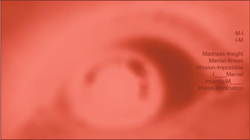 mental illness, racism, marginalised narratives, digital Technology, community evolution/engagement mental illness, racism, marginalised narratives, digital Technology, community evolution/engagement
M-I I-M, as an ongoing project, endeavours to engage with themes that are not in primary spheres of discourse, to generate knowledge. This poster discusses multiplicities and heterogeneity. It endeavours to engage with themes that are not in primary spheres of discourse, as well as addressing both lack of representation and misrepresentation. The project, currently finding focus with a net art work, pages of madness, is a response to recent scientific research of Professor Robin Murray of the Institute of Psychiatry, which suggests that black people in the United Kingdom are several times more likely than white people to suffer mental illness. The research points to social factors such as racism that cause such huge demographic discrepancy. Professor Murray believes that the experience of black people in the U.K. almost drives them mad. |
|
Last Updated ( Aug 07, 2006 at 01:57 AM )
|
|
Read more...
|
|
|
on moss - topology of a plant |
|
Aug 04, 2006 at 12:00 AM |
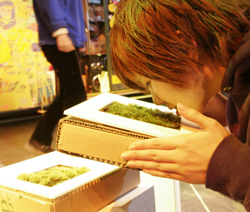 organism, tactile, generative, theoretical tool, method, device, local, global interface organism, tactile, generative, theoretical tool, method, device, local, global interface
"The moss plant earns our respect, even our sense of awe, as one of the worlds lengthier successes in the business of living" (George Schenk, Timberpress, 1997).
An investigation of the topological characteristics of moss.
The unique botanical features of moss qualify as a background for the analysis ofphenomena which require a topological approach. The characteristics of the growth process are: 1. Territorial growth of genetically identical clusters. 2. Mutual support of the
plantlets of one cluster. 3. Clusters have a layered structure. Illustations are by Ingela Viks.
|
|
Last Updated ( Aug 07, 2006 at 02:05 AM )
|
|
Read more...
|
|
|
Aug 04, 2006 at 12:00 AM |
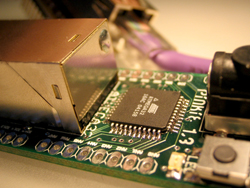 social software, tangible media, interactive architecture, sensor networks, computer supported collaboration, social and economic networks social software, tangible media, interactive architecture, sensor networks, computer supported collaboration, social and economic networks
Open I/O is a suite of software services and applications for composing and running distributed physical media in a way that enables people to exchange data over the Internet. By using this system, artists and designers can collaborate and take advantage of high-level social and economic information while creating low-level physical interactions. By enabling social interactions through networked electronic objects, Open I/O lets people explore the intersection of material culture (things, physicality) and ideology
(ideas, values).
|
|
Last Updated ( Aug 04, 2006 at 08:38 PM )
|
|
Read more...
|
|
|
The Other Free Trade (S4G3) |
|
Jul 13, 2006 at 01:54 PM |
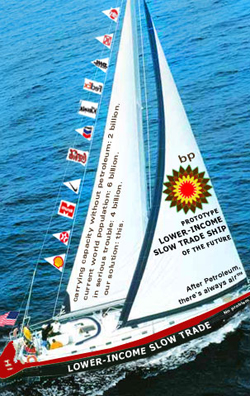 mobile systems, networks, DIY, interactive, public art, autonomy, fossil fuels, wifi, ecology, tours mobile systems, networks, DIY, interactive, public art, autonomy, fossil fuels, wifi, ecology, tours
We will rent a 40-foot or longer boat and use it for social and activist projects for which a sailboat is a unique and essential venue. The boat's first major voyage (a "trading voyage of the future" especially targeting communities with diaspora components) will be from Lázaro Cárdenas, Michoacán to a port near San Jose, California. The six-week voyage will take place prior to August 2006, and the results (as well as the boat itself) will be displayed at ISEA '06, where we will also offer tours of Bay industrial ports. |
|
Last Updated ( Aug 07, 2006 at 02:06 AM )
|
|
Read more...
|
|
|
Apr 23, 2006 at 10:49 PM |
Transvergence Over the last five years, Processing.org has grown from a small software initiative to an international community. The software is used by thousands of students, artists, designers, architects, researchers, and hobbyists for learning, prototyping, and production. It is created to teach fundamentals of computer programming within a visual context and to serve as a software sketchbook and professional production tool. Processing is developed by artists and designers as an alternative to proprietary software tools in the same domain. The related projects Mobile Processing, Wiring, and Arduino extend the ideas behind Processing to the contexts of developing software for mobile phones and for interfacing to the world through controlling sensors and motors. These tools are used around the world for teaching in universities, art schools, and arts organizations. Each of these environments will be discussed in relation to education, prototyping, and production. |
|
Last Updated ( Aug 07, 2006 at 02:02 AM )
|
|
Read more...
|
|
|
Re-imagining the Electronic Journal |
|
Written by Kuniko Vroman
|
|
Apr 23, 2006 at 10:33 PM |
electronic journal, digital publication, new media, scholarship, research, academic This poster presentation will demonstrate several aspects of the new electronic publication Vectors Journal of Culture and Technology in a Dynamic Vernacular, together with its conception, mandates, infrastructure and funding, as well as its attempts at community building, and innovative collaborative design and interface development process. It is designed to spark discussion about the future of electronic publishing and its potential impact across a broad spectrum of academic output. |
|
Last Updated ( Aug 07, 2006 at 01:48 AM )
|
|
Read more...
|
|
|
Aug 04, 2006 at 12:00 AM |
online collaboration, social exchange systems, trust, agreements and compensation in virtuality and voluntary projects, resource-exchange, resource sharing network, working realities of collaborative non-profit practices, supporting self-organized initiatives Thinktank tries to open the process of developing a groupware to practitioners from the arts and social and cultural production. In a research phase we gather the expectations, requirements and wishes towards online collaborative spaces, which pay attention to the dynamics which appear in voluntary working processes, such as agreements, compensation, and trust, but also practical aspects such as conferring online, and publishing (printing on demand). In collaboration with other partners, the conceptual design emerging from the research phase will lead to new add-on modules, to be attached to the existing groupware drupal. Furthermore the Thinktank will develop a new user-friendly interface. |
|
Last Updated ( Aug 04, 2006 at 08:34 PM )
|
|
Read more...
|
|
|
Written by Kuniko Vroman
|
|
Apr 23, 2006 at 10:51 PM |
alternative Energy, wind power, solar power, geothermal power, alternative energy technology, energy, fossil fuel, networksUnnatural Selection is an umbrella for a series of projects that examine human and cultural understanding of and relationship to the natural environment. The project is a collaboration between University of California, Santa Cruz Assistant Professor of Art Elliot Anderson and Digital Arts New Media graduate students: Tyler Freeman, Adam Jerugim, James Khazar, Nichole Smith, Synthia Payne, no.e sunflowrfish, and Alan Tollefson. The designation Unnatural Selection was chosen to comment on and question human manipulation of the natural world. The work in the series reflects on current perceptions of biology, nature, and the environment from the point of view of environmental aesthetics, genetics and human desire, the sublime and genetic technologies, and the necessity of creative involvement in generating ethical and technologically less destructive interaction with the natural world.
|
|
Last Updated ( Aug 04, 2006 at 04:55 PM )
|
|
Read more...
|
|
|
|
